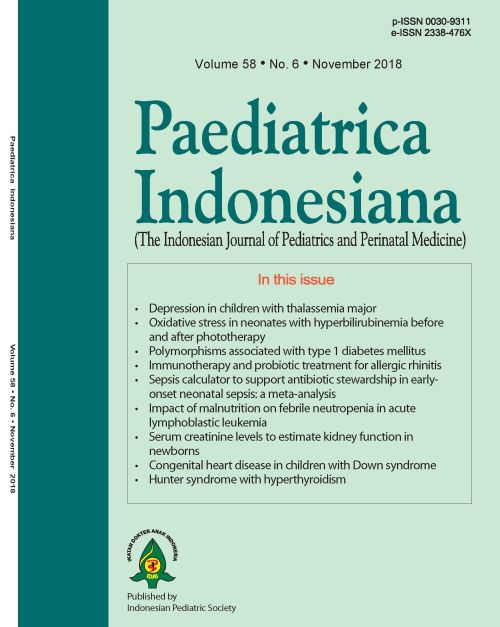Oxidative stress in neonates with hyperbilirubinemia before and after phototherapy: malondialdehyde and catalase activity
DOI:
https://doi.org/10.14238/pi58.6.2018.269-73Keywords:
hyperbilirubinemia, oxidative stress, malondialdehyde, catalase activity, phototherapyAbstract
Background Phototherapy is used to treat neonatal hyperbilirubinemia, but is currently thought to cause photodynamic stress and can induce lipid peroxidation. There is increasing evidence that many severe diseases of the neonates are caused by oxidative injury and lipid peroxidation. In the present communique, we review the oxidative succeptibility of the neonate and the evidence now available that phototherapy induces oxidative stress. Malondialdehyde (MDA) is a metabolic product of free radicals. Catalase is a antioxidant that binds free radicals.
Objective To compare the levels of oxidants and antioxidants before and after phototherapy in neonates with hyperbilirubinemia.
Methods This pretest-posttest control group study was conducted in Sanglah Hospital, Bali from November 2016 to April 2017. Thirty babies with gestational age ≥35 weeks and hyperbilirubinemia with total bilirubin levels requiring phototherapy were included in this study. The MDA levels and catalase activity were measured before and after 24 hours of phototherapy.
Results Comparative analysis using paired T-test showed a significant increase of malondialdehyde level, with mean MDA 23.73 (SD 8.20) nmol/mL before and 53.05 (SD 10.18) nmol/mL after phototherapy (P<0.001). However, catalase activity significantly decreased from of 72.33 (SD 10.63) kU/L before phototherapy to 44.85 (SD 14.79) kU/L after phototherapy (P<0.001). The MDA level had a significant, negative association with catalase activity after phototherapy (r =-0.4; P=0.028).
Conclusion Neonates with hyperbilirubinemia are found to have increased oxidative stress after phototherapy, as indicated by increased MDA levels and decreased CAT activity after 24 hours of phototherapy.
References
Mishra S, Agarwal R, Deorari AK, Paul VK. Jaundice in the newborns. Indian J Pediatr. 2008;75:157-63. https://doi.org/10.1007/s12098-008-0024-7 PMid:18334797
Blackburn S. Maternal, fetal & neonatal physiology, a clinical perspective. 3rd ed. St. Louis: Saunders Elsevier; 2007. p.105-23.
Vreman HJ, Wong RJ, Stevenson DK. Phototherapy: current methods and future directions. Semin Perinatol. 2004;28:326-33. https://doi.org/10.1053/j.semperi.2004.09.003 PMid:15686263
Maisels MJ. Neonatal jaundice. Pediatr Review. 2006;27:443-54. https://doi.org/10.1542/pir.27-12-443
Xiaong T, Qu Y, Cambier S, Mu D. The side effects of phototherapy for neonatal jaundice: what do we know? What should we do? Eur J Pediatr. 2011;170:1247-55. https://doi.org/10.1007/s00431-011-1454-1 PMid:21455834
Aycicek A, Erel O. Total oxidant/antioxidant status in jaundice newborns before and after phototherapy. J Pediatr (Rio J). 2007;83:319-22. https://doi.org/10.1590/S0021-75572007000500006 https://doi.org/10.2223/JPED.1645 PMid:17625638
Dahiya K, Tiwari AD, Shankar V, Kharb S, Dhankhar R. Antioxidant status in neonatal jaundice before and after phototherapy. Indian J Clin Biochem. 2006;21:157-60. https://doi.org/10.1007/BF02913086 PMid:23105589 PMCid:PMC3453759
Gulbayzar S, Arica V, Hatipoglu M, Kaya A, Arica S, Karatekin G. Malondialdehyde level in the cord blood of newborn infants. Iran J Pediatr. 2011;21:313-9. PMid:23056807 PMCid:PMC3446175
Block G, Dietrich M, Norkus EP, Morrow JD, Hudes M, Caan B, et al. Factors associated with oxidative stress in human populations. Am J Epidemiol. 2002;156:274-85. https://doi.org/10.1093/aje/kwf029 PMid:12142263
Abdel Latief DAK, Sabry RN, Youness IR, Fathy GA. The effect of phototherapy on the oxidant stress status in neonatal hyperbilrubinemia. Int J Acad Res. 2012;4:17-22. https://doi.org/10.7813/2075-4124.2012/4-4/A.3
Thiagarajan AN, Chand P, Bhat BV, Sridhar MG. Assessment of oxidative stress in babies under phototherapy for neonatal jaundice. Int J Adv Med Health Res. 2014;1:66-8. https://doi.org/10.4103/2349-4220.148004
Buettner GR. Molecular targets of photosensitization. [cited 2017 March 12]. Available from http://photobiology.info/Buettner.html.
Jetawattana S. Malondialdehyde (MDA), a lipid oxidation product. Free Radicals in Biology and Medicine Spring. 2005;77:222.
Demirel G, Uras N, Celik IH, Aksoy HT, Oguz SS, Erdeve O, et al. Comparison of total oxidant/antioxidant status in unconjugated hyperbilirubinemia of newborn before and after conventional and LED phototherapy: a prospective randomized controlled trial. Clin Invest Med. 2010;33:E335-41. https://doi.org/10.25011/cim.v33i5.14359 PMid:20926040
Downloads
Published
How to Cite
Issue
Section
License
Authors who publish with this journal agree to the following terms:
Authors retain copyright and grant the journal right of first publication with the work simultaneously licensed under a Creative Commons Attribution License that allows others to share the work with an acknowledgement of the work's authorship and initial publication in this journal.
Authors are able to enter into separate, additional contractual arrangements for the non-exclusive distribution of the journal's published version of the work (e.g., post it to an institutional repository or publish it in a book), with an acknowledgement of its initial publication in this journal.
Accepted 2018-11-26
Published 2018-12-13


















